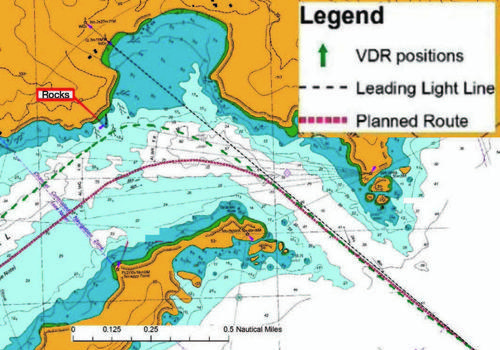202439 BRM failure contributes to shore contact
As edited from TAIC (New Zealand) report MO-2016-202A passenger vessel was inbound for a port in daylight conditions. Visibility was moderate, but still in excess of one nm. Under the effect of the tidal stream, the vessel was travelling at 12 knots. A pilot was taken on board before entering the more restricted waters closer to the port area, and an exchange of information was accomplished. When the pilot asked about the turning characteristics of the vessel, the Master mentioned that the ship was highly manoeuvrable and would ‘turn on a dime’. He added that a three-degree helm order would create a rate of turn of 10-15 degrees per minute.
As the vessel approached the first turn to port, the pilot was concerned that too much initial port helm would be detrimental due to the tidal push from the northeast. Recognising the good manoeuvrability of the vessel, he ordered three degrees of port helm. By now the vessel was making almost 18 knots due to the tidal stream partially astern.
Although a navigation officer was assigned duties at the ECDIS and radar, at no point did he give data on the vessel’s progress such as actual track versus planned track. Nonetheless, the pilot soon realised that the ship was not turning to port as expected, so he ordered five degrees of port rudder followed by 10 degrees in quick succession. The ship was now to the right of the intended track and the cross-track distance from the intended track was increasing rapidly to starboard.
The staff captain noticed the predictor on the ECDIS/Radar display had the ship passing over the land ahead and to starboard. He suggested to the Master that they increase the rate of turn. The Master reassured the staff captain that the cross currents were strong and would bring the ship back to the middle of the channel, reiterating what the pilot had explained during the pilot/Master information exchange.
Soon, an off-track alarm visually flashed on the ECDIS, although audible alarms had been muted before entering the restricted waterway. The ship had departed the predefined safety corridor either side of the planned track, but this information was not brought to the attention of the Master or pilot. Yet, by now they both realised that the ship was proceeding dangerously close to the rocks on the starboard side. Twenty degrees of port rudder was ordered, immediately followed by maximum port rudder. The ship responded with a rapid turn to port. When the ship was approaching the closest point to the rocks on the starboard side, the Master ordered maximum helm to starboard in an attempt to arrest the rapid port turn and prevent the stern from striking the rocks. The ship’s bilge keel and the starboard propeller nonetheless made contact as they passed the rocks. The ship was then navigated back to the centre of the channel and continued on its passage to port without further incident.

Lessons learned
- The concept of allowing a ship to depart from an intended track in the belief that other influences, such as tide in this case, would return the ship to that track carries a high risk when manoeuvring large ships in narrow waterways where margins for error are small. There is less risk involved when a ship is kept strictly to the intended track by increasing or decreasing its rate of turn in response to the influences of factors such as tide and wind.
- Also, the above manoeuvring method leaves other members of the bridge team tasked with monitoring the progress of the ship against the planned track in limbo. How can an officer or Master ‘challenge’ the person with the con if the situation is intentionally obscure or undefined?
- Good BRM practices help to ensure that the best decisions are made and any errors or malfunction of equipment are identified and corrected before an incident can develop. In order to achieve this objective and navigate a ship safely, a shared understanding of the passage plan by the entire bridge team is critical.
